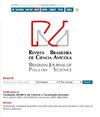1811蜂胶提取物的农业杀菌剂作用
IF 1.1
4区 农林科学
Q3 AGRICULTURE, DAIRY & ANIMAL SCIENCE
引用次数: 1
摘要
蜂胶是一种富含酚类化合物和类黄酮的树脂产品,由蜜蜂生产。本研究旨在从分类类群、紫外-可见光谱(UV-Vis)、抗菌核菌(Sclerotinia sclerotiorum)、炭疽菌(Colletotrichum gloeosporioides)和尖锐炭疽菌(Colletotrichum acutatum)的生物活性等方面进行评价。蜂胶是在永久保存区内采集的。采用静态浸渍法制备乙醇提取物。根据皮肤颜色进行分类,紫外可见分光光度计在450 ~ 800 nm范围内测定,在不同浓度的PDA体外培养基中对菌丝体、gloeosporioides和acutatum的抑菌活性均以百分比(%)表示。蜂胶提取物适用于12 SP12组,紫外-可见光谱鉴定出黄酮类化合物和酚类化合物的存在,抗真菌活性表明S. sclerotiorum对两种炭黑菌更敏感。本文章由计算机程序翻译,如有差异,请以英文原文为准。
Agricultural fungicidal effect of Tetragonisca angustula Latreille, 1811 propolis extract
Propolis is a resinous product rich in phenolic compounds and flavonoids produced by bees. This study aimed to evaluate the propolis of Tetragonisca angustula regarding its classification group, ultraviolet and visible spectroscopy (UV-Vis) and its antifungal biological activity against Sclerotinia sclerotiorum, Colletotrichum gloeosporioides and Colletotrichum acutatum phytopathogens of grains and fruits of interest commercial. Propolis was collected from T. angustula hives in a permanent preservation area. The ethanolic extract was produced by static maceration. The classification group according to the dermal color, the determination of the bands were obtained in a UV-Vis spectrophotometer between 450-800 nm, the antifungal activity carried out in in vitro PDA medium at different concentrations on S. sclerotiorum, C. gloeosporioides and C. acutatum and expressed as a percentage (%). The group in which T. angustula propolis extract fits is the 12 SP12 group, UV-Vis bands identified the presence of flavonoids and phenolic compounds and the antifungal activity demonstrated that S. sclerotiorum is more sensitive when comparing the two species Colletotrichum fungi evaluated.
求助全文
通过发布文献求助,成功后即可免费获取论文全文。
去求助
来源期刊

Brazilian Journal of Poultry Science
农林科学-奶制品与动物科学
CiteScore
1.80
自引率
9.10%
发文量
60
审稿时长
>12 weeks
期刊介绍:
A Revista Brasileira de Ciência Avícola surgiu em 1999 a partir da necessidade que a comunidade científica possuía de um periódico para veiculação e publicação de seus trabalhos, com a publicação de três números anuais.
A Revista conta hoje com um corpo editorial altamente qualificado e com artigos científicos desenvolvidos pelos maiores especialistas da área, o que a cada dia atrai mais leitores em busca de inovação e respaldo técnico.
Devido à credibilidade que conquistou pelos esforços de sus autores, relatores e revisores, a Revista ganhou caráter de coleção, sendo consultada como fonte segura de estudo desenvolvidos na Avicultura.
A partir de 2003 – volume 5 -, a Revista passou a chamar-se Brazilian Journal of Poultry Science, e todos os trabalhos passaram a ser publicados em inglês. No mesmo ano subiu para quatro o número de revistas por volume, ampliando-se assim os trabalhos publicados anualmente.
 求助内容:
求助内容: 应助结果提醒方式:
应助结果提醒方式:


